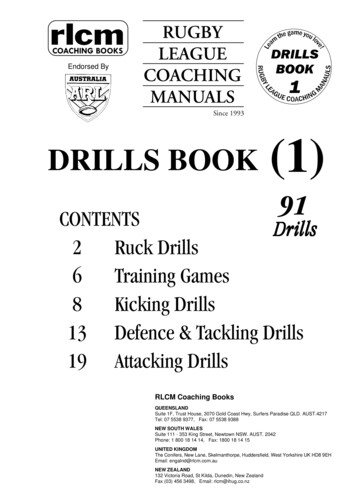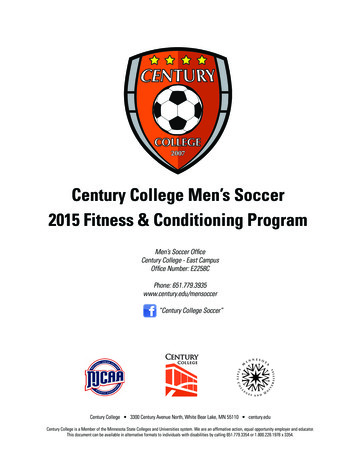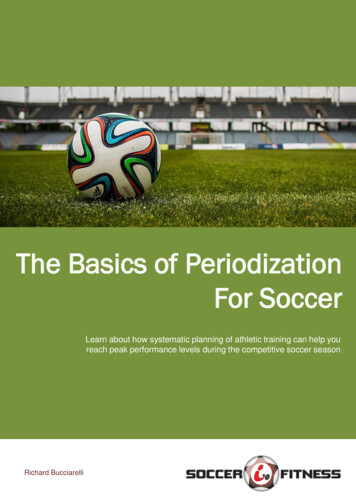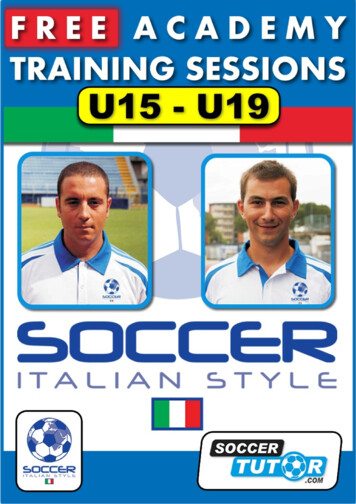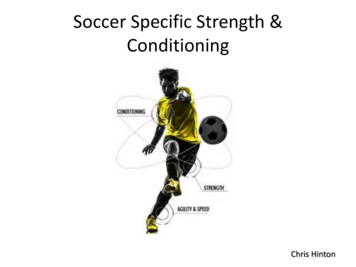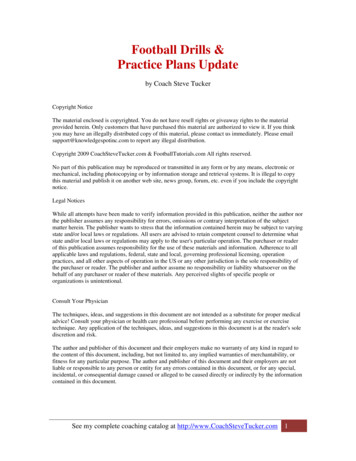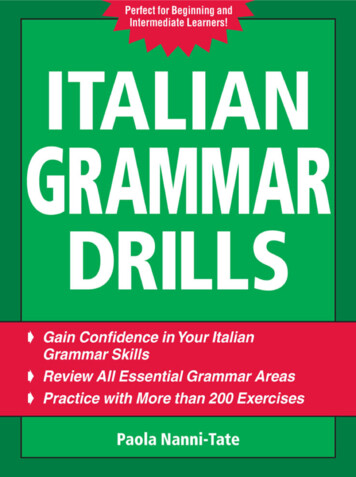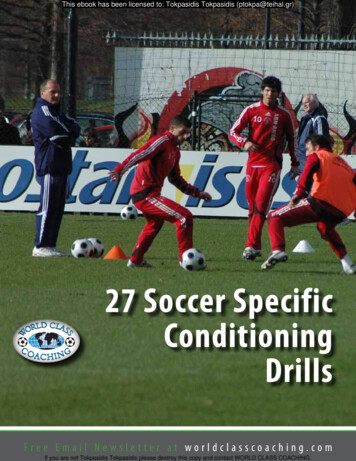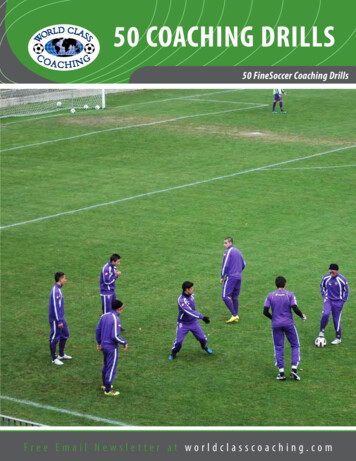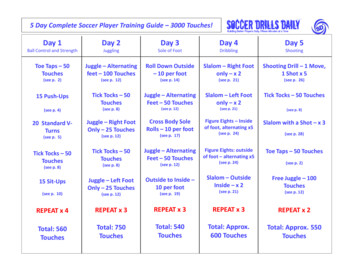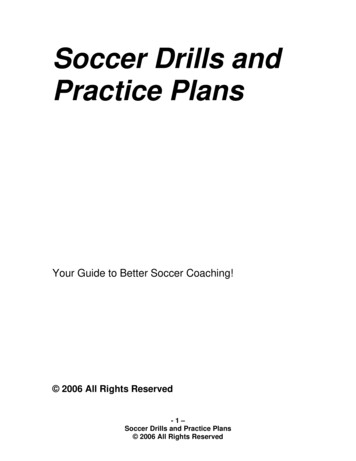
Transcription
Soccer Drills andPractice PlansYour Guide to Better Soccer Coaching! 2006 All Rights Reserved-1–Soccer Drills and Practice Plans 2006 All Rights Reserved
Table of Contents-2–Soccer Drills and Practice Plans 2006 All Rights Reserved
Introduction – How to Use this book!Soccer coaches are constantly on the lookout for drills and skills that are going tomake their players better. Further, being able to put those drills together with apractice plan to reinforce those skills makes it all the more effective. That’s goingto be the goal of this guide.Practice makes perfectWe have all heard that saying, and it really is true. Repetition of skills is the bestway to get your players to perform better. Knowing what to do when theopportunity presents itself is one of the hallmarks of a good player. The moreyou practice, the more inclined your players are to do the right thing at the righttime. Skill development in essential to having a good soccer team.Practicing the drills included in this book are going to help your players continueto develop their playing habits and improve their overall skill level. We havedivided this book into three different skill areas that you can focus on: Ball ControlPassing and ShootingSoccer TacticsThe drills included in this book will range in skill / age level based on theirdifficulty. Some of the more advanced drills you certainly aren’t going to use forU-8 or U-6. Likewise, the more basic skills, like kicking the ball and receiving it,aren’t going to be reinforced if you are at a U-17 level of soccer.Each drill’s skill level will be denoted by the following symbols:Beginner (U-8 and under):Intermediate (U-8 to U-14)Advanced (U-14 and up)-3–Soccer Drills and Practice Plans 2006 All Rights Reserved
Planning practicesAfter you have a few more drills under your belt, it is important to structure thosedrills into an effective practice. We will also include 25 different practice plans touse throughout a season. Each of these practice plans will be geared towards aspecific skill or set of skills and each will continue to build off one another.You don’t have to use all of the practice plans! We have included severaldifferent ones so you can choose the ones that work best for you and your team.As a coach, you will probably only choose the ones where your team needs themost attention. With our practice plans, you can simply print the ones you wantoff your computer and you will be ready to go!Ready to go!The first section of this book will be the various drills, divided into three separatesections. Then you will notice those drills included in a the practice plans wehave provided for you in the second half of the book.Once you have gone through this book, you will be armed with a number of greatdrills and an idea of how to implement them for your team! Then, you watch astheir skills get better and you become more confident as a coach!Best of luck!-4–Soccer Drills and Practice Plans 2006 All Rights Reserved
Ball Control and Defensive drillsBall control could be the most important element of the game. In order to scoregoals on the field, you need to be able to get and maintain the ball. This involvesshielding it, dribbling it, and using different skills to do so. In this section, we willtake on some of the soccer skills that are going to help your team improve in thisarea. Make sure you look for symbol indicating what age group the drillsare for!Put your foot downStopping the ball is the first step in gaining control of it.What you need – Depending on the number of coaches you have, you might beable to run more than one line. All you need is a ball, and your players in singlefile lines facing you about 10 yards away.How this drill works – You need to roll the ball toward your players and theyneed to stop it by putting their foot on top of the ball. This is actually moredifficult than it sounds for many kids – and that is why it is important to do it.You can vary the difficulty of this drill as kids get the hang of things: make themgo to their right or left to stop the ball, and you can roll the ball harder.Results – After repeating this drill time after time, you will notice a significantincrease in the ability of your players to stop and control the ball before movingon.Short dribbleDribbling is another skill that must be mastered. Aside from kicking the balldownfield, this is the way to move the ball into opposing territory.What you need – In this drill you can set up a couple of lines with an area ofabout 10 yards to work with. This will be a shorter dribbleHow this drill works – In the first line, you need to get players to work the ballback and forth between their feet, over 10 yards. This will help them dribble theball in a short area, and also build up the dexterity in both of the feet. You canshorten up the area if you want, and you can also ask the kids to try and keeptheir head up as they try to dribble the ball in that area.-5–Soccer Drills and Practice Plans 2006 All Rights Reserved
Result – With a little bit of repetition, your players will soon master the skill ofdribbling in a short area, using both feet to handle the ball.Long DribbleAs a child is bursting down the field and they have to be able to carry the ballwith them. The short dribble requires too much attention and lacks speed.What you need - Set up two lines, and extend the area that the players dribblethe ball from 10 yards to 40 yards.How this drill works – In order to build the long dribbling skills of your playersthey need to be taught to kick the ball far enough ahead of them, in stride, sothey can take a few full strides when they run. Coaches should start out bygetting kids to use their dominant leg and to kick the ball and then run after it.Once kids can simultaneously kick and run (dribbling), then you can try it withtheir non-dominant leg.Results – Kids will naturally learn to kick the ball far enough in front of them sothey can run with the ball, rather than have to short dribble the ball ahead of them– taking much longer.Stop, turn and dribbleThis puts a couple of the skills together into one drill that will help them learn thebasics of soccer.What you need – Set up a pylon (or two for two stations), and have the childrenline up facing the coach.How this drill works - Roll the ball (or kick it) to the players, have them stop itand turn to go outside the pylon and then short dribble for 5 yards. To make itmore difficult, have the players stop the ball and the turn to their non-dominantside.Working both sides will help the players learn to go either direction to get out oftrouble when opposing players attack them.Result – The players will be able to control the ball better, and then they will bealso be more confident in stopping the ball and then taking off with it down thefield.-6–Soccer Drills and Practice Plans 2006 All Rights Reserved
SpacemanGetting rid of the ‘pack’ mentality is important early in soccer. Spacing betweenplayers is a good skill to learn.What you need – Give all of the kids in the group a soccer ball. Place 4 pylonsequal distance apart, creating a squared area of about 25 yard by 25 yards.How this drill works – Give the kids a ball and have them make sure they areequal distance between each other to start. They should be about 10 to 12 feetaway from one another. When the coach blows the whistle the players mustdribble the ball around the inside of the pyloned area.Players must try to maintain that 10 to 12 feet between all of the other players onthe field. The only way they are going to be able to do this is to keep their headsup and make sure they know where the other players are. Coaches shouldemphasize the importance of spacing when players are passing and trying tomove the ball.Results – Your players will gain the skill of dribbling with their heads up (seeingthe field), and also making sure they maintain appropriate space between eachother.Stuck in the mud (game)This incorporates the game of frozen tag with the ability of the players to keepcontrol of the ball.What you need - You will need three or four players that are going to dribblearound to try and tag players (who are also dribbling).How this drill works – Players will be able to have a little fun by playing a gamethat forces them to use the skills they have learned, combined with a game thatchildren love to play.Players need to keep control of their ball and elude the taggers. If they arecaught, they must wait standing with their legs open and their arms out. Otherplayers still in the game must put a ball between the players’ legs in order to setthe player free.This works on skills like dribbling, keeping the head up, and gives the kids achance to exercise their skills while playing a game.Result – Fun!-7–Soccer Drills and Practice Plans 2006 All Rights Reserved
Finger GameThis is continued learning and reinforcement of dribbling with your head up.What you need - Place four cones in a 30 yard by 30 yard area. Give all of theplayers inside the square a ball. The coach will be in the middle of the square.How this drill works – All of the players should be evenly spaced out, with theball, ready to dribble. When the coach blows the whistle, the players will dribblearound the square, maintaining space and keeping their head up.At different intervals the coach will hold up his or her hand and display a certainnumber of fingers. The players must shout out the number of fingers the coachis holding up. Players who don’t see it, or aren’t looking up at the hand, areeliminated. After eliminating a few players, you can make the square smaller,emphasizing shorter ball control skills.Result – Players are going to continue to develop their ball control skills. Alongwith that players will get the knack for being able to dribble the ball with theirheads up.Truck and trailerMore ball control skills but this time it forces a player to mimic the direction of theperson in front of them.What you need – Two players are partnered together with two balls.How this drill works – You might think this drill is simple, but it can actually beused at all levels. It is far more difficult than a coach might think, but it developsexcellent ball control skills.As a truck and trailer would do, one must follow the other. The player in frontmust dribble the ball, change directions, move around, sprint, run, etc theplayer behind is the trailer and must keep within a few short paces of the truck.This forces a player to watch what the player ahead of them is doing, but also tomaintain control of the ball so they can follow the player close enough. Tocomplicate the drill further, add a tandem trailer!Results – Another ball control drill that will help players learn to work in closequarters and to quickly react to what others are doing and still keep control of theball.-8–Soccer Drills and Practice Plans 2006 All Rights Reserved
Shielding the ballPlayers will have to learn to shield the ball from defenders, while maintainingcontrolWhat you need – Players should be paired up with someone close to their ownskill level and one ball should be given per pair.How this drill works – The player with the ball will use a combination of theirshort dribble and their long dribble to keep the ball away from the other player.When the coach blows the whistle, the player with the ball has to stop the ball,keep control and get their body in between the opponent and the ball.The object is not for the defender to take the ball, but rather for the ball carrier tomaintain control of the ball, and to get their body in the way of the defender toprotect it. To do this effectively, they will need to have their head up and on aswivel to identify the direction the player is coming from. If the defender cantouch the ball with a toe, then the two players switch sides.Result – Those controlling the ball will learn to control under pressure and toshield themselves from defenders when in tight.Body part controlPlayers must begin to learn how to stop and control the ball with other parts oftheir body – including their head, chest, midsection, inner thigh and inside of thefoot / ankle.What you need – Players can be in two lines, with coaches tossing, rolling orthrowing balls from on each side.How this drill works – Coaches should challenge the players to control the ballwhen it comes to them from a variety of directions and speeds. Learning to getinto position, and cushioning the ball is extremely important.Coaches should toss the ball so it reaches the player at a variety of angles, withthe player needing to determine how they are going to receive and control theball. They are going to need to learn how much cushion to give the ball, and withwhat part of the body to control it with when in the air.Result – The ball comes to players at a variety of different angles – it doesn’talways come in a nicely-wrapped pass. This drill will help them learn to controlthe ball no matter where the ball comes from.-9–Soccer Drills and Practice Plans 2006 All Rights Reserved
Z TurnsPlayers should learn to gain control of the ball and maintain it while changingdirection.What you need – You will need to set up a pylon course that will facilitateplayers moving from side to side (see diagram). Two lines can be set up soplayers can get more repetition.How this drill works – Players will need to dribble with both feet in this drill andkeep control of it as they negotiate a course similar to the one below:Players will need to use both feet to keep their ball under control, and theyshould try to negotiate the entire course with a few stops as possible.Result – Better ball control, and improvement using both feet to dribble.Control on the runPlayers need to learn to be able to control the ball (from a pass, throw in, ordeflection), while they are on the run.What you need – All you need is a line of players that are ready to get into a fullsprint and looking for the ball to come to them.How this drill works – Once the players are ready to run, they can take off at asprint with the player looking back at the coach. The ball is going to come atthem either as a pass, a lob, or even just a deflection making the ball tough togather and control.Result – Players are going to be at a slow jog or run a lot during a game ofsoccer. The ball doesn’t always come to them nicely, so they need to learn howto control the ball while they are going full speed.- 10 –Soccer Drills and Practice Plans 2006 All Rights Reserved
Sharks and MinnowsA great game for players to learn to keep their head up and keep control for theolder players.What you need – Give all of the players except two or three, a ball to control anddribble around a given area.How this drill works – This drill is to help players continue with their ball controlskills while having a little bit of fun playing a game. The two or three playerswithout balls are going to try and take the balls away from the other players thatare trying to maintain control.If a player has their ball taken away, then they go on the offensive and try to takeaway the ball from other players. Put something on the line and have playersthat finish up without a ball do laps, line or maybe even pushups.Result – anytime you play a game like this one, your players will gain a little bitof conditioning, but they also have a chance to continue honing their skills in afun way.Quick controlBeing able to change directions and get your bearing to control the ball when thepace is fast is a good skill for players to learn.What you need – One player should be in the middle of a circle of five or sixother players. Each circle should have three balls.How this drill works – With the player in the middle, they must keep their headon a swivel and listen for their players calling to them to receive a pass. Once aplayer in the circle calls (to your right, left, behind!) then the player in the middlemust turn in their direction and get into a ready position to receive a pass.The players in the circle are very important in this drill. They need to give theplayer a variety of passes to try and control. This will develop the quick reactionskills. You can vary the difficulty of the drill by increasing the speed in whichplayers call out their direction – or, add another ball.Result - Players will be able to make quick decisions when they hear theirplayers call for passes, and to control them quickly.- 11 –Soccer Drills and Practice Plans 2006 All Rights Reserved
Fighting RoostersKeeping the ball from someone who is trying to get it is a fundamental ball controlskill for older playersWhat you need – Pair players up of similar skill ability. Give them two ballsbetween the pair.How this drill works: Each player has a ball and they are moving about arelatively small area (10 x 10 yards). During this drill, each player has tomaintain control of their ball, but tries to touch the other player’s ball with the toeof their foot.Players will have to maintain control of their own ball during this drill, and cannotgain a point for touching the other person’s ball if theirs isn’t controlled. Playersshould be working on keeping their head up, focusing on the ball and then tryingto get into their opponent’s space to touch their ball.Result – Your players will become more aware of what is going on around them.They will have to keep their ball under control, but still score points on the otherplayers by touching it.Target ManCreating space to receive and control a pass is crucial for ball control at higherlevels.What you need – One player (you can use goalies) will be in the passing line,another in the receiving line and another in the defending line.How this drill works – The player in the receiving line will need to spring outfrom the middle of the practice field to the side, with the defender in tow (about20 yards away from the passers). At this point, the passer will kick the ball to thetarget man (receiver). The receiver must create an area for him or her to receivethe pass and keep the defender from intercepting it.This is an important element of ball control. One of your players has the ball andis trying to pass it to another teammate. If it is intercepted, you lose ball control.Result – Players will learn to shield the defender from the ball to allow the passto come to them unimpeded.- 12 –Soccer Drills and Practice Plans 2006 All Rights Reserved
Catch the tiger’s tailThis drill is like Fighting Roosters, but there is only one ball. Creating space andusing your arm to create a zone around you are skills players should be workingon in this drill.What you need – Match players up with similar skills. Give them one ballbetween the pair.How this drill works – This is a way for players to feel real defensive pressureas their opponent doesn’t have a ball this time while they are trying to get it. Thedefender doesn’t try to take the ball away, but they do try to do any of thefollowing: cause a loss of control, to nudge the ball away from their opponent, orto simply touch the ball with their toe.Coaches shouldn’t be afraid to let players go for a couple of minutes, and theninsert coaching tips when the whole group is listening. Try to emphasize usingthe arms to keep a player at a distance, using the body to create a barrier for thedefender, and to maintain ball control and keeping the head up.Result – This is a great drill for players because each side will compete witheach other to get control of the ball. Players should switch up each time thedefender contacts the ball, and keep score in the match.Long pass controlOften players will need to control the ball off of a long pass from midfield into theattacking zone.What you need - One line of passers (or just the coach passing with two stationsof players).How this drill works – The pass receivers will streak down the side of the fieldand the passer from the middle will kick the ball deep to the player going downthe field. The player receiving the pass will have to control the pass either in theair or off of the bounce.It is important to stress the different ways that a player can try to corral the pass(head, chest, thigh, etc.). To make the drill more of a challenge, add a group ofdefenders to follow the player down the field.Result – Better long pass control for your team.- 13 –Soccer Drills and Practice Plans 2006 All Rights Reserved
One on one’sOne on one skills are important to develop – both for ball control and for ballhandling.What you need – Pair players up with opponents of equal skill. Give eachplayer an area of about 10 yards wide by 20 yards long. Put a small goal(pylons) at the end of each side.How this drill works – This is a good old-fashioned game that pits two playersagainst one another. This is just a microcosm of the game situation that needs tobe understood and perfected for players to get to the top of their game.The players need to get the ball away from each other and try to get it into theiropponent’s goal. Players must be no further than a couple of steps(uncontested) away from their opponent’s goal in order to score. Kicks from theother side of the playing area do not count as goals.Emphasize keeping the ball protected, good ball control, and dribbling skills.Result – Players will be able to build their one on one skills and get the feeling ofplaying in a tense game situation.One touch, one bounce (juggling)This is a drill that builds a player’s body and eye coordination, and their ballcontrol skills.What you need – Each player gets his or her own ball, and they need an area ofabout 5 yards by 5 yards.How this drill works – Many veteran soccer players will be familiar with this one– mainly because they have probably done it since they were kids. But, it is agreat ball control drill. Have the player contact the ball with an area of their body(instep, knee, toe) and kick the ball (touch) about waist height. Then the playerneeds to let the ball bounce on the ground. Then they hit the ball again with oneof the areas of the body, let it bounce, and so on. Do this 20 times.Increase the difficulty over time by increasing the number of touches in a row (2touches, one bounce, 3 touches, one bounce, etc.) Alternate feet.Result – Excellent ball control skills built over time.- 14 –Soccer Drills and Practice Plans 2006 All Rights Reserved
Head controlPlayers need to be able to use their heads to control the ball when it is up in theair.What you need – You need partners paired up with a ball.How this drill works – Using several different types of passes, the players needto learn to control the ball using their heads. It is one thing for the player to leapup and head the ball forward, backward or in any direction it springs from theirhead.But, it is clear that the head is a valuable tool to control the ball when it is uphigh. This is what players need to work on. Using their head to direct the ball totheir feet where they have more control.To do this, each player tosses or softly kicks the ball in the air for the other playerto get under and use their head to control.Result – Players will learn to use their head not only to advance or retreat theball, but to control it at their feet.Break the concentrationBeing aware of the action around you is important to keeping control of the ball.What you need – Four passers staggered over a 20-yard straightaway. Each ofthe passers has a ball. There will be one dribbler at the start of the 20 yards.How this drill works – The object of the game is to try and break theconcentration of the player dribbling the ball along the 20-yard course. Thepassers will kick their ball towards the player dribbling the ball at half pace downthe field.The ball carrier should attempt to dodge (or field, if they can) the balls that arebeing kicked at them. All of this while maintaining control of the ball. What thisrequires is good ball control skills, keeping the head up, and good dribbling.Result – There are a lot of distractions during a game, and a player must be ableto maintain their focus and be able to react quickly to the certain situations duringthe game. They’ll learn that in this drill, or they will get hit with the ball.- 15 –Soccer Drills and Practice Plans 2006 All Rights Reserved
Passing and ShootingNow that ball control is mastered, your players need to know what to do with theball to either advance it, or to score with it. Passing and shooting are the nextskills that the players are going to have to practice. Accuracy and propertechnique are important in both areas, and the drills that you see in this nextchapter are going to help your players excel in these areas.Inside the footThis is the primary passing area used by soccer players and should be learnedproperly at an early age.What you need – Have two rows of players line up across from each other about8 to 10 yards apart, depending on their skill level.How this drill works – This is a basic skill to learn for younger players(nonetheless important), and the drill itself is just as basic. With the playersfacing each other, they must pass the ball back and forth, focusing on: passingthe ball using the instep of their foot and stopping the ball for ball control.Result – Players will soon learn the appropriate area they need to contact theball and continue working on pass reception and ball control.Marbles gamePassing accuracy is important to maintain control of the ball.What you need – Put together four or five players in a group and give them eacha ball.How this drill works – The first player will ‘pass’ the ball, about 10 yards in frontof them. Then, the next player tries to ‘pass’ the ball to hit the other ball. Thenthe next player and the next player, with each player trying to aim for and hitperson’s ball previous to them.Result – With players using their proper passing skills, they will develop properdistance and accuracy each time they try to get the ball to hit the person beforethem.- 16 –Soccer Drills and Practice Plans 2006 All Rights Reserved
Passing circle (1st level)Players will need to learn to be aware of a pass coming from them at any time.What you need – Create two or three circles of players with one ball for eachcircle.How this drill works – At first, you should use one ball for this drill, but asplayers get better, you can add two, or even three balls.With players around in a circle, one player starts off by passing it to a teammatewithin the circle. The player receiving the pass must stop the ball, and then passit to another player. As players get better at this drill, the passes will becomequicker, and the players will need to be more aware of what is going on in orderto receive the pass.As mentioned earlier, you can increase the level of difficulty by adding a secondball, and if the players are up for it – a third ball. Proper passing and passreception is important.The Big KickPlayers should learn the proper shooting technique when they are young, so theycan build power as they gain experience and age.What you need – You need a couple of nets (or goals set up), and two lines ofplayers equipped with balls.How this drill works - Often times, younger players will simply stride into theball when they are running in order to kick it. While the intent is good, learning todo this properly starts with learning the proper stationary kick.Go through the proper shooting form – planting foot, contact point and then thefollow through with the kids and get them to kick the ball at the net. Most kids willwant to try and kick the ball hard, but get them to slow down and try to keepthings under control so they can learn to kick properly.You can ensure the players that they will learn to kick it harder once they learnhow to kick it properly. Watch their progress, and you can even mark how far achild can kick the ball as the year progresses.Result – Ultimately this is a drill that teaches kids the fundamentals of shootingthe ball. Power and accuracy will come down the road.- 17 –Soccer Drills and Practice Plans 2006 All Rights Reserved
Hit the runnerSimilar drill to the learning to pass receive on the run, this one focuses on how topass to players that are running.What you need – Two lines; one with passers and one with runners. You canhave two separate groups for this if you have the numbers.How this drill works – First, explain that you need to lead the runner with thepass in order for them to get it in stride. Show them how much harder it is toreceive the ball if it is behind you than in front of you.As the runner takes off, the player will have to try and gauge the speed of therunner and send a pass to that player. The runners should try and vary theirspeed – not always running as fast as they can, but sometimes just jogging andother times maybe just standing still in the line.Make sure the runners are also working on their pass control skills (stopping theball, and gaining control).Result – As the marbles game helped players learn stationary accuracy, this drillwill help the player learn to pass accurately to a player that is moving.Target Shooting (1st level)Learning accuracy is a great tool for kids to learn at an early age. Finding therange is essential in scoring goals.What you need – Set up a series of goals (maybe three or four) so players canget the most chance at shooting for the targets. Divide the players up intogroups at each net.How this drill works – Set up a target (it could be a pylon, a box, or a devicethat knocks over when a player hits it) inside the goal. Each player will have achance to hit the target from about 10 yards out.Each rotation that the players go through, you move the target to a different areaof the net – so they have to adjust their shooting. The next step is to move theplayers back a bit so they have to kick the ball harder to get it to the target.Results – Players will learn to develop a ‘range’ for certain areas of the net. Asthey get older, the difficulty level of this drill will c
Ball Control and Defensive drills Ball control could be the most important element of the game. In order to score goals on the
